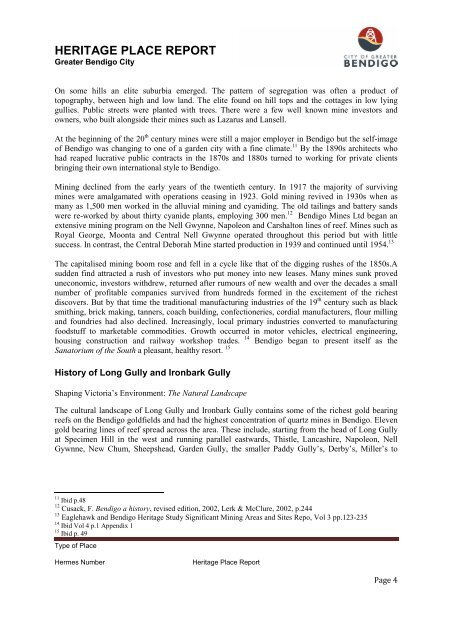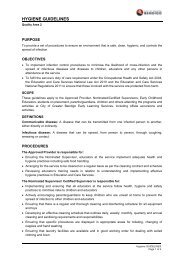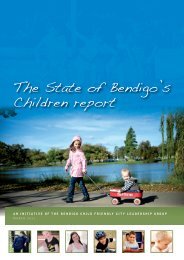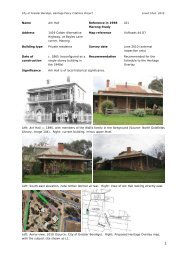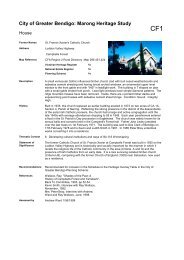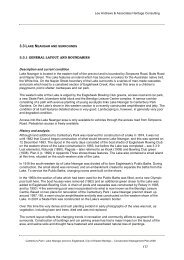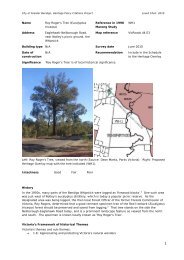HERITAGE PLACE REPORT - City of Greater Bendigo
HERITAGE PLACE REPORT - City of Greater Bendigo
HERITAGE PLACE REPORT - City of Greater Bendigo
Create successful ePaper yourself
Turn your PDF publications into a flip-book with our unique Google optimized e-Paper software.
<strong>HERITAGE</strong> <strong>PLACE</strong> <strong>REPORT</strong><br />
<strong>Greater</strong> <strong>Bendigo</strong> <strong>City</strong><br />
On some hills an elite suburbia emerged. The pattern <strong>of</strong> segregation was <strong>of</strong>ten a product <strong>of</strong><br />
topography, between high and low land. The elite found on hill tops and the cottages in low lying<br />
gullies. Public streets were planted with trees. There were a few well known mine investors and<br />
owners, who built alongside their mines such as Lazarus and Lansell.<br />
At the beginning <strong>of</strong> the 20 th century mines were still a major employer in <strong>Bendigo</strong> but the self-image<br />
<strong>of</strong> <strong>Bendigo</strong> was changing to one <strong>of</strong> a garden city with a fine climate. 11 By the 1890s architects who<br />
had reaped lucrative public contracts in the 1870s and 1880s turned to working for private clients<br />
bringing their own international style to <strong>Bendigo</strong>.<br />
Mining declined from the early years <strong>of</strong> the twentieth century. In 1917 the majority <strong>of</strong> surviving<br />
mines were amalgamated with operations ceasing in 1923. Gold mining revived in 1930s when as<br />
many as 1,500 men worked in the alluvial mining and cyaniding. The old tailings and battery sands<br />
were re-worked by about thirty cyanide plants, employing 300 men. 12 <strong>Bendigo</strong> Mines Ltd began an<br />
extensive mining program on the Nell Gwynne, Napoleon and Carshalton lines <strong>of</strong> reef. Mines such as<br />
Royal George, Moonta and Central Nell Gwynne operated throughout this period but with little<br />
success. In contrast, the Central Deborah Mine started production in 1939 and continued until 1954. 13<br />
The capitalised mining boom rose and fell in a cycle like that <strong>of</strong> the digging rushes <strong>of</strong> the 1850s.A<br />
sudden find attracted a rush <strong>of</strong> investors who put money into new leases. Many mines sunk proved<br />
uneconomic, investors withdrew, returned after rumours <strong>of</strong> new wealth and over the decades a small<br />
number <strong>of</strong> pr<strong>of</strong>itable companies survived from hundreds formed in the excitement <strong>of</strong> the richest<br />
discovers. But by that time the traditional manufacturing industries <strong>of</strong> the 19 th century such as black<br />
smithing, brick making, tanners, coach building, confectioneries, cordial manufacturers, flour milling<br />
and foundries had also declined. Increasingly, local primary industries converted to manufacturing<br />
foodstuff to marketable commodities. Growth occurred in motor vehicles, electrical engineering,<br />
housing construction and railway workshop trades. 14 <strong>Bendigo</strong> began to present itself as the<br />
Sanatorium <strong>of</strong> the South a pleasant, healthy resort. 15<br />
History <strong>of</strong> Long Gully and Ironbark Gully<br />
Shaping Victoria’s Environment: The Natural Landscape<br />
The cultural landscape <strong>of</strong> Long Gully and Ironbark Gully contains some <strong>of</strong> the richest gold bearing<br />
reefs on the <strong>Bendigo</strong> goldfields and had the highest concentration <strong>of</strong> quartz mines in <strong>Bendigo</strong>. Eleven<br />
gold bearing lines <strong>of</strong> reef spread across the area. These include, starting from the head <strong>of</strong> Long Gully<br />
at Specimen Hill in the west and running parallel eastwards, Thistle, Lancashire, Napoleon, Nell<br />
Gywnne, New Chum, Sheepshead, Garden Gully, the smaller Paddy Gully’s, Derby’s, Miller’s to<br />
11 Ibid p.48<br />
12 Cusack, F. <strong>Bendigo</strong> a history, revised edition, 2002, Lerk & McClure, 2002, p.244<br />
13 Eaglehawk and <strong>Bendigo</strong> Heritage Study Significant Mining Areas and Sites Repo, Vol 3 pp.123-235<br />
14 Ibid Vol 4 p.1 Appendix 1<br />
15 Ibid p. 49<br />
Type <strong>of</strong> Place<br />
Hermes Number Heritage Place Report<br />
Page 4


